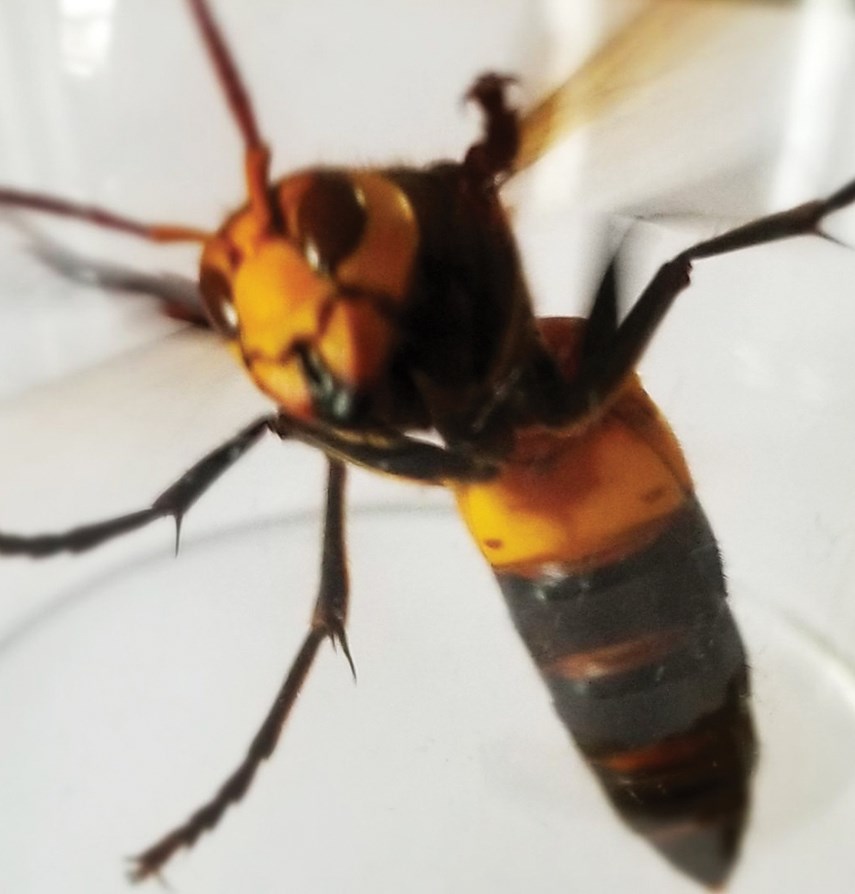When Valerie Greer’s boyfriend brought home an unusual insect in a bottle on Friday, she admits her first reaction was to run away.
The angry-looking insect was like something out of a nightmare, she said.
“It was about two inches long. The face looked like the face of the Green Hornet.”
Now experts are saying the North Vancouver couple may have stumbled upon a serious find – a giant hornet not normally found in North America. If confirmed, the early discovery could prove important in trying to halt the spread of the invasive species.
Greer’s partner was at work in an office on the Vancouver waterfront when the extra-large insect came to his attention. “A co-worker asked if he had seen this bug flying around,” said Greer. When he spotted the wasp-like bug on a window screen, her boyfriend used a cup and a piece of paper to trap it and scoop it into a clear plastic container.
“He knew that this insect didn’t belong here,” she said, and wanted to get it properly identified.
When he brought it back to their North Vancouver home on Friday, the bug was very much alive. “It was bouncing the bottle on the table,” said Greer.
After speaking to a few entomologists, the couple have learned the insect – possibly a Japanese giant hornet or another species of hornet from Asia – could very well be horror-movie worthy – especially in terms of its potential impact on populations of local honey bees.
“Everyone is more than a little horrified that this thing may have made its way across the Pacific,” said Greer.
Leonard Foster, a professor of biochemistry and molecular biology who studies bees at the University of British Columbia, said while he hasn’t had a chance to examine the insect first-hand yet, from the description it sounds like a Japanese giant hornet, which is not good news for the local environment.
Like other hornets, the bug can be aggressive, but more worrying, “It’s a predator of honey bees,” he said. “It can really decimate honey bee colonies.”
Some Japanese honey bees have developed unique defences, said Foster – including surrounding the hornet in a swarm and vibrating together to raise the temperature and essentially kill the insect through overheating.
Karen Needham of the Beaty Biodiversity Museum said it’s possible the hornet could be a different species from that part of the world.
Regardless, the non-native hornets are very bad news for Western honey bees.
Most likely, the hornet came across the Pacific in some kind of container shipment, said Foster.
The crucial question is whether the hornet is an isolated individual or part of a colony.
Foster said while he’s hoping there is no colony, past experience with the arrival of invasive species indicates that could be wishful thinking.
On the advice of experts, Greer and her boyfriend simultaneously dispatched and preserved their hornet by putting the plastic container in the freezer. They plan to deliver it to experts at UBC this week.
If anyone else spots a similar insect, Foster says they should consider calling local entomologists and reporting it. That will give experts a jump on determining how much of a threat the hornets pose to honey bee populations, he said.
The most obvious marker for a non-native hornet is its size – the hornets can grow to four or five centimetres long.



